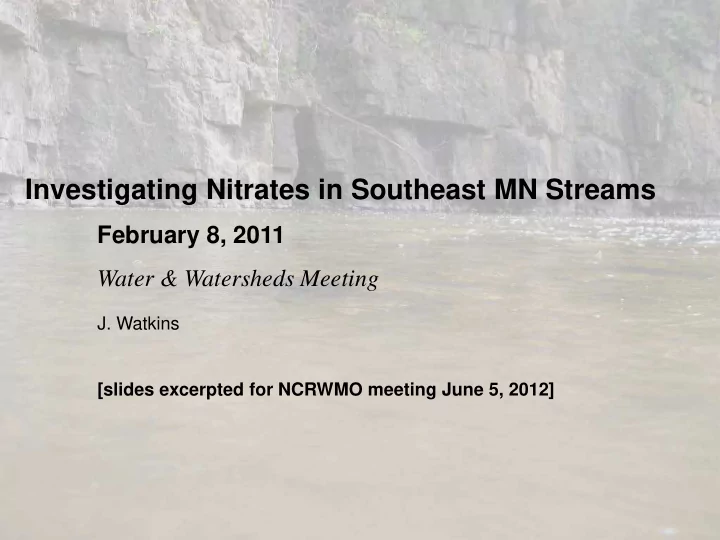

Investigating Nitrates in Southeast MN Streams February 8, 2011 Water & Watersheds Meeting J. Watkins [slides excerpted for NCRWMO meeting June 5, 2012]
Presentation Outline • Nitrate concerns • Land use vs nitrate • Work in Trout Brook
Nitrate pollution is a multi-faceted concern: • Excessive nitrates in groundwater can impair drinking water sources; • Freshwater river and stream ecosystems have been found to be sensitive to nitrate concentrations; • Loading of excess nutrients (including nitrate) to still-water systems (lakes, reservoirs, Gulf of Mexico) accelerates eutrophication, a problem that can lead to extremely low levels of dissolved oxygen, as in the Northern Gulf of Mexico.
High nitrate concentrations in drinking water have been linked to the occurrence of methemoglobinemia in infants, and may increase cancer risks in adults (Weyer PJ, Cerhan J, Kross BC, Hallberg GR, Kantamneni J, Breuer G, et al., 2001).
Nitrate as Stressor of Aquatic Life • Nitrates are toxic to aquatic organisms by way of the conversion of oxygen-carrying pigments to forms that are unable to carry oxygen (Grabda et al, 1974). In a review of nitrate toxicity to aquatic animals, Camargo et al. (2005) concluded that toxicity to aquatic organisms increases with increased exposure and nitrate concentrations. • Some invertebrates, fish and amphibians can have suffer detrimental effects during long exposures to elevated nitrate concentrations. Nitrate levels in the range of 10 mg/L can result in impaired reproductive success for some salmonid fish populations (Kincheloe et al., 1979). • As part of its triennial review of water quality standards MPCA staff are developing an aquatic life toxicity standard. This includes a broad literature review and a public comment period. Bullets 1 &2 from Laing, Magner, Jasperson, Felix, Sandberg, Stroom 2009
Preliminary : one-time Bug IBI vs one-time Nitrate Grab Sample Southern Coldwater sites in Root River only The solid line is the 50 th percentile, the dashed lines are the 25 th and 75 th percentiles, and the dotted lines are the 5 th and 95 th percentiles. In all three plots the 50 th percentile crosses the biocriteria at about 6 mg/L of nitrogen. This could be interpreted as having a 50/50 chance to attain the biocriteria at this concentration. The 75 th percentile line crosses the biocriteria at ~12-13 mg/L for all stations and the Root (25% chance of meeting the biocriteria). Approx 13 of the 17 sites that showed > 10 mg/l NOx did not meet bug criteria. All but a few sites that showed < 4 mg/l NOx met bug criteria.
Nitrate: Downstream Considerations • University of Iowa: Weldon & Hornbuckle: …evaluated nutrient concentrations and fluxes in four eastern Iowa watersheds sampled between 1996 and 2004. We found that these watersheds contribute nearly 10% of annual nitrate flux entering the Gulf of Mexico, while representing only 1.5% of the contributing drainage basin. Environmental Science & Technology, 2006.
Credit: Mark Boswell (printed in Star Tribune, January 30, 2011) Used with permission of the Star Tribune.
Trout Run pic here In bedrock-dominated, karst settings, the underlying aquifer readily takes on the character of the land above. That character is expressed in the baseflow of the associated trout streams. If the land is rich in nitrogen, the aquifer will be rich in nitrogen, and so will the trout stream.
Percent Row Crop vs Baseflow Nitrate Concentration in Bedrock-Dominated Watersheds of SE MN ; n = 100 20.00 y = 0.1657x + 0.0087 R² = 0.6832 18.00 16.00 14.00 Baseflow Nitrate Concentration (mg/l) 12.00 10.00 8.00 6.00 4.00 2.00 0.00 0.0 10.0 20.0 30.0 40.0 50.0 60.0 70.0 80.0 Percent Row Crop (corn + soy acres, 2009)
Recommend
More recommend